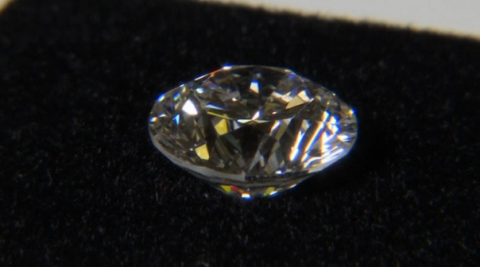

NEW JERSEY, United States (Reuters) — They are real diamonds. That’s what the industry behind diamonds made inside a scientific laboratory wants you to believe.
“All the composition is exactly the same. It is a real diamond. What we’ve done is we’ve just taken what’s happened in nature and just put it in a lab,” said Kelly Good, the director of marketing for Pure Grown Diamonds.
Currently, the lab-grown diamond industry is small, but it is growing fast. And the $14 billion (B) dollar global rough diamond market, according to Morgan Stanley, is taking notice.
Lab-grown diamonds, are just what they sound like.
They are diamonds that are grown inside a laboratory using pure carbon in a process that simulates what happens in nature, but just speeds up the process by a few thousand years.
Inside a laboratory in Singapore, workers inspect and select a diamond seed.
Then dozens of seeds are placed inside the chamber of a diamond greenhouse.
Using a scientific method called microwave plasma chemical vapour deposition, a plasma ball made of hydrogen is created inside the chamber.
Methane, which is a carbon source, is added.
The carbon mix rains down on the diamond seeds, layer by layer, creating a rough diamond that is cut and polished.
The process takes about 10 to 12 weeks.
Good said the lab-grown diamonds simply offer consumers another choice and young buyers like a product they feel is eco-friendly and non-conflict.
“Our consumer is millennials, anybody who is getting engaged are really buying the lab-grown diamonds. They also like the fact of the environmental aspect of it. That it’s grown in a greenhouse. There is less soil being moved. We have a less carbon footprint,” said Good.
Good said lab-grown diamonds tend to cost about 30 to 40 percent less than mined diamonds of the same carat, color, cut and clarity.
Near New York City’s Diamond District, gemologist David Weinstein, who is also the executive director of the International Gemological Institute in New York, said the only difference between a lab-grown and a mined diamond is its origin and only a high-powered microscope can be used to tell the difference between the two.
In addition to growth patterns, Weinstein said inclusions can offer details to a diamond’s origin. Weinstein said elements found underground can sometimes mix with natural diamonds.
“I have a crystal, a diamond and I’m looking at it and I see a peridot crystal, a green peridot crystal, I know right away, this wasn’t created in a machine. So the inclusions can really be very telling as to what the origins of the material is. And that’s what our gemologists look for.”
To help distinguish mined diamonds from lab-grown, all lab-grown diamonds are required to have a laser inscription identifying them as lab-grown.
Lab-grown gems have been around for decades, but it’s only recently that the science and technology have made it possible to grow large, colorless diamonds. Pure Grown Diamonds said they can grow IIA (two-A) diamonds as large as five carats. IIA diamonds are so rare and colorless, only two percent of mined diamonds are graded IIA, according to Frost and Sullivan which is a market research and consulting company.
According to another report by Morgan Stanley, as of now, the lab-grown diamond market is about one percent of global rough diamond market, but it predicts the lab-grown diamond market could grow to 15 percent by 2020.
